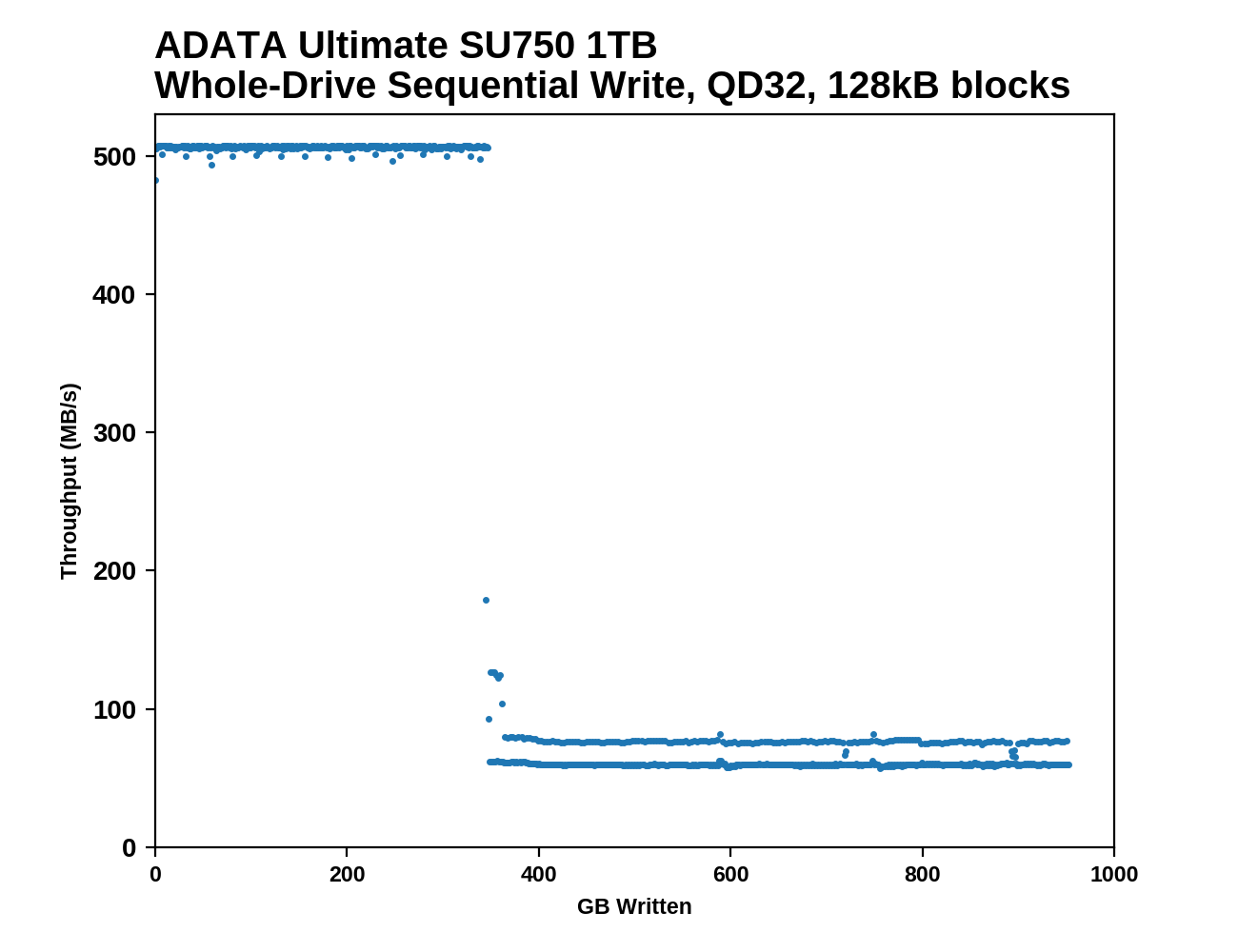The ADATA Ultimate SU750 1TB SSD Review: Realtek Does Storage, Part 1
by Billy Tallis on December 6, 2019 8:00 AM ESTWhole-Drive Fill
This test starts with a freshly-erased drive and fills it with 128kB sequential writes at queue depth 32, recording the write speed for each 1GB segment. This test is not representative of any ordinary client/consumer usage pattern, but it does allow us to observe transitions in the drive's behavior as it fills up. This can allow us to estimate the size of any SLC write cache, and get a sense for how much performance remains on the rare occasions where real-world usage keeps writing data after filling the cache.
 |
|||||||||
The SLC write cache on the 1TB ADATA SU750 is quite large, lasting for about 345GB of sequential writes before performance drops down to QLC-like speeds. In both phases, the performance is very consistent, and the transition when the SLC cache fills up is abrupt.
 |
|||||||||
| Average Throughput for last 16 GB | Overall Average Throughput | ||||||||
The post-cache write speed of the SU750 is actually even slower than the QLC-based Samsung 860 QVO, but the much larger cache on the SU750 means its overall average write speed across the entire drive filling process is slightly faster.
Working Set Size
When DRAMless SSDs are under consideration, it can be instructive to look at how performance is affected by working set size: how large a portion of the drive is being touched by the test. Drives with full-sized DRAM caches are typically able to maintain about the same random read performance whether reading from a narrow slice of the drive or reading from the whole thing. DRAMless SSDs often show a clear dropoff when the working set size grows too large for the mapping information to be kept in the controller's small on-chip buffers.
 |
|||||||||
The QD1 random read performance of the SU750 is fairly low regardless of the working set size. There's no clear indication of performance being affected by the size of the controller's caches for mapping information. Even when the random reads are confined to a mere 1GB slice of the drive, performance is no better than when reading from the entire drive. The Intel 660p is the only drive in this bunch that does show a clear performance drop, caused by it having a 256MB DRAM cache instead of the more typical 1GB for a 1TB drive.










54 Comments
View All Comments
sonny73n - Friday, December 6, 2019 - link
Realtek does audioRealtek does networking
Realtek does storage
Debbie does Dallas
RadiclDreamer - Friday, December 6, 2019 - link
Realtek may do all of these things, but it does them all poorly.FunBunny2 - Friday, December 6, 2019 - link
"Realtek may do all of these things, but it does them all poorly."Debbie wasn't so hot either. :):)
boozed - Friday, December 6, 2019 - link
I don't know that I'd call them poor. Good value, reliable (in my experience) and good enough for the vast majority of users.Other options are available for enthusiasts.
eek2121 - Friday, December 6, 2019 - link
The trouble is that you are talking about a few dollars for a much faster and more power efficient drive. This controller appears DOA as it brings nothing unique to the table.Samus - Saturday, December 7, 2019 - link
With what Intel charges for network controllers, it’s astonishing Realtek is in business when you consider how superior an Intel NIC is while being a few dollars more. And wireless is a whole different story. I’d put Realtek at the absolute bottom of the list. Atheros/Qualcomm, Intel, Agere, Lucent, Broadcom, all have better reliability, support (which is shocking when you consider how vastly used Realtek products are) and generally - performance, than competing Realtek solutions.I think where Realtek scores is availability. Their volume shows commitment to OEM’s that require dependable shipping schedules. This can be as important is BOM pricing, and when you look at the numbers, it seems (and I’m speculating) Realtek designs products for volume production more than anything else. The incredibly low pin count and a 2 channel controller back this up. We are talking about possibly the most basic SATA SSD controller in production and that means they will be able to make a shitload of them really fast really cheap.
And unfortunately OEMs will bite because they know 90% of the people buying this crap don’t care about the inner margin performance of an SSD. Most people buy on price, reliability and warranty.
This shitty SSD May have all 3 bases covered considering the quality binning of Micron NAND.
close - Saturday, December 7, 2019 - link
"a few dollars more" adds up when buying by the truckload. With millions of devices that have a network chipset that's quite some money.jabber - Sunday, December 8, 2019 - link
Yeah amazing how many people don't realise how shaving just 50 cents off a product that will sell hundreds of thousands to millions will save a company a fortune and help with profit.A good example is to watch the documentary "Building a Faster Horse" on how Ford designed and built the 2016 iirc Ford Mustang. Every single part and component was scrutinised to see if it could be either removed/simplified or made cheaper.
That's why Realtek exists still. Their parts are 50c cheaper than Intels.
Manch - Monday, December 9, 2019 - link
Ford been making the Mustang cheaper and cheaper while charging more and more. Started with the Getrag MT-82 grenade and got worse with the crap IRS, corner cutting everywhere. Add on top of it a horrid design (Looks like a 2 door Focus) and they wonder why they're losing customers.hanselltc - Saturday, December 7, 2019 - link
Killer